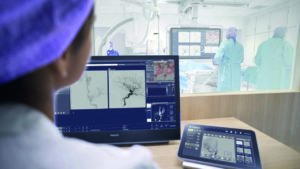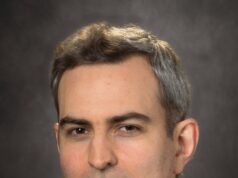
Interventional News speaks with Atul Gupta about the future of interventional radiology (IR). As a chief medical officer for Image-Guided Therapy, Philips, he enthuses about the possibilities of radiation-free interventional procedures, and a medical world advanced by augmented reality and artificial intelligence solutions.
How was IR changed over the course of your career?
I have been practicing for about 20 years, so when I first started my career, it was simple: just X-ray and a device. Procedures are becoming increasingly complex. When I do an intervention today, it is no longer just X-ray and device—I have to analyse data from a whole bunch of sources: haemodynamic data, electronic health records, 2D and 3D live imaging, intravascular ultrasound (IVUS) and ablation data.
I have also seen a change in the types of procedure that we do. My entryway to the human body used to be the femoral artery, but now, as we do things like uterine fibroid embolization (UFE), prostate artery embolization (PAE), transarterial chemoembolization (TACE), peripheral vascular disease (PVD) work, and even biliary procedures, we have several different access points: radial, pedal, femoral, jugular, transabdominal. I want to be able to rapidly image wrist to wrist, from head to toe, and I need to be able to do it very quickly and with great image quality. That is the biggest change I have seen in the last 20 years, the increased complexity of these procedures. Fortunately, technology now exists to help us make these procedures a lot more efficient.
What are the challenges for today’s interventional radiologists, and how can these be overcome?
At CIRSE 2019 [the annual meeting of the Cardiovascular and Interventional Radiological Society of Europe; 7–11 September, Barcelona, Spain], we heard a lot about how we as a specialty have an identity crisis. Not just with patients, but also with other physicians. It is well understood that cardiologists treat the heart, neurologists treat the brain—but what do interventional radiologists treat? Put simply, everything, everywhere. What other field can treat a liver blockage, a stroke patient, a trauma patient, a prostate patient, kill a kidney tumour, and drain from the lungs, all in one day? We do it all, and that is a challenge. But there are three ways I think you can overcome this identity issue.
Firstly, education in the impressionable years. Any individual specialist knows us for our procedures specific to them: gynaecologists know us as the UFE expert, trauma doctors know us for doing splenic embolization, and geriatricians know us as the people who perform kyphoplasties. They are amazed to hear of all the things that we do outside of their specialty. At CIRSE, the European Trainee Forum bought 300 medical students to the congress. Not all of those 300 are going to go into IR, but they will be IR ambassadors for us, as they learn about all the things that we do.
Secondly, interdisciplinary congresses such as VIVA, ISET, CX and CIRSE, where all these specialists from across disciplines gather, are important.
Finally, social media, which gives us interventional radiologists the opportunity to get the word out is increasingly playing a role.

What technological developments do you think will be the most disruptive in IR?
Lots of things! That is the cool part of the job, I get a glimpse of the future and help define what the next five to ten years of innovation are going to be, and the world that I and my colleagues are going to work in. Philips is an innovation company, so we are very much about creating technology, but it is very important to remember that it is not just about the technology. We are not here to push technology for technology’s sake—technology is the enabler to help physicians do a procedure better.
I think we are going to be working increasingly in a radiation-less, or maybe even radiation-free, world. We are going to be using ultrasound instead of X-ray. We [at Philips] have technology called TrueView, where I can photo-realistically render 3D ultrasound on the fly, so I can guide a device using ultrasound and see it in 3D, maybe even see it in a hologram in the world of augmented reality (AR). In addition to sound, we are going to be using light to navigate our devices instead of X-ray. Philips is developing devices using technology called Fibre-Optic RealShape (FORS), which lets me visualise wires and catheters in 3D using light, instead of X-ray; this was presented to the world through first-in-human cases shown at the 2019 Leipzig Interventional Course (LINC; 22–25 January, Leipzig, Germany), the International Symposium on Endovascular Therapy (ISET; 27–30 January, Hollywood, USA), and the Charing Cross Symposium (CX; 15–18 April, London, UK). Philips acquired EPD Solutions last year, and we now have a new technology called dielectric imaging, which lets you visualise not just the device, but the anatomy, in high definition and 3D, without X-ray. If we can do all this imaging without X-ray, and support it with artificial intelligence (AI), this is, I think, going to be massively disruptive, not just for IR, but for all interventionalists.
What can other medical disciplines learn from IR?
I think that collaboration is the most important thing that interventional radiologists bring to the table. We know that no two patients are the same, and so we are often asked by other specialities to solve very unique problems, and that lets me as an interventional radiologist be creative. Interventional radiologists are the innovators; we are always inventing new ways of treating patients. That is a hot topic every year, from the annual meeting of the Society of Interventional Radiology (SIR) to CIRSE. By collaborating with industry and with other physicians, the procedures that we develop disseminate into other fields. I think that other medical disciplines love interventional radiologists’ passion for innovation and creativity, but most importantly for collaboration. If I fast forward 10 or 15 years, I would not be surprised to see a blurring of lines between specialties, because a lot of the procedures that we do are increasingly overlapping. What specialist today is the expert in critical limb ischaemia (CLI), or AAA, or venous disease? Many people: cardiologists, surgeons, and interventional radiologists. I think that we are starting to see physicians meet across specialties. I saw vascular surgeons, cardiologists, and radiologists joining CIRSE. At conferences like ISET and Vascular InterVentional Advances (VIVA), we also see multiple specialties coming together. None of us work in a vacuum, and so crossing over to approach patient care is extraordinarily important, not just for physicians, but also for industry. Collaboration leads to the very best in innovation.
How are you working to shape the future of IR?
This is the part of my job that I like the best, the innovation piece. The process of how we innovate and co-create with physicians is both extraordinary and fascinating, because you never want to just push technology out, everything has to start with the end-user and patient. Recently, we brought teenagers into our innovation centre, and allowed them to sit in an interventional suite and start playing with it. These adolescents were born after the iPhone was introduced in 2007, and they are going to be the physicians of the future. Their insights are tremendous. So the process starts early on, but we also work with the world’s leading interventionalists to help us improve our devices, imaging, and software.
Atul Gupta is chief medical officer for Image-Guided Therapy, Philips. He is also a practicing interventional radiologist in Philadelphia, USA.












Hi,
I really enjoyed this article and thought it offered a really personal view on the innovation and future of IR. I wanted to know if I could have permission to base an Education poster for Medical students/ Junior doctors interested in IR?
Kind regards,
Dr Miguel da Costa
ED Education Fellow
Chelsea and Westminster NHS foundation Trust